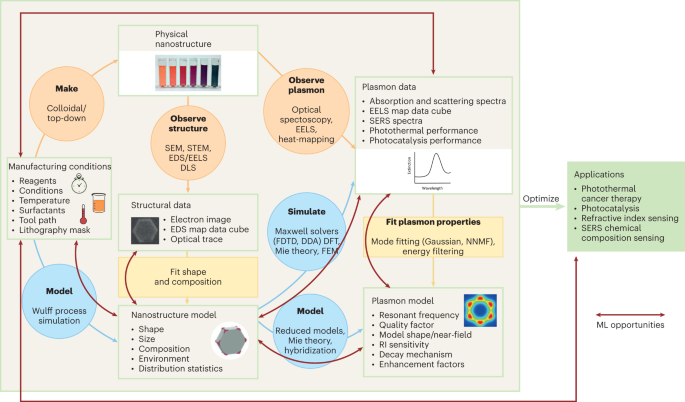
Machine learning for nanoplasmonics
- Select a language for the TTS:
- UK English Female
- UK English Male
- US English Female
- US English Male
- Australian Female
- Australian Male
- Language selected: (auto detect) - EN
Play all audios:

Plasmonic nanomaterials have outstanding optoelectronic properties potentially enabling the next generation of catalysts, sensors, lasers and photothermal devices. Owing to optical and
electron techniques, modern nanoplasmonics research generates large datasets characterizing features across length scales. Furthermore, optimizing syntheses leading to specific
nanostructures requires time-consuming multiparametric approaches. These complex datasets and trial-and-error practices make nanoplasmonics research ripe for the application of machine
learning (ML) and advanced data processing methods. ML algorithms capture relationships between synthesis, structure and performance in a way that far exceeds conventional simulation and
theory approaches, enabling effective performance optimization. For example, neural networks can tailor the nanostructure morphology to target desired properties, identify synthetic
conditions and extract quantitative information from complex data. Here we discuss the nascent field of ML for nanoplasmonics, describe the opportunities and limitations of ML in
nanoplasmonic research, and conclude that ML is potentially transformative, especially if the community curates and shares its big data.
We acknowledge the financial support of the Natural Science and Engineering Research Council of Canada, The Royal Society, UK, International Exchange Scheme IES\R3\203092 and UKRI Future
Leaders Fellowship programme, grant number MR/S017186/1.
Département de chimie, Quebec Center for Advanced Materials, Regroupement québécois sur les matériaux de pointe, and Centre interdisciplinaire de recherche sur le cerveau et l’apprentissage,
Université de Montréal, Montréal, Quebec, Canada
Engineering Department, University of Cambridge, Cambridge, UK
Department of Material Science and Metallurgy, University of Cambridge, Cambridge, UK
Department of Earth Science, University of Cambridge, Cambridge, UK
Nature Nanotechnology thanks Regina Ragan and Xiaonan Wang for their contribution to the peer review of this work.
Publisher’s note Springer Nature remains neutral with regard to jurisdictional claims in published maps and institutional affiliations.
Springer Nature or its licensor (e.g. a society or other partner) holds exclusive rights to this article under a publishing agreement with the author(s) or other rightsholder(s); author
self-archiving of the accepted manuscript version of this article is solely governed by the terms of such publishing agreement and applicable law.
Anyone you share the following link with will be able to read this content:
